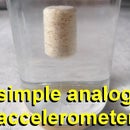Introduction: DIY Wind Tunnel and Visualized Airstreams for the Physics Lesson
Hello!
In my physics laboratory in one unit we treat the air resistance and the calculation of the cw value. This indicates how windy a body (such as a car) is. The formula for the aerodynamic resistance is:
Fr = 1/2 * cw * A * ro * v²
with
A .... the cross-sectional area of the object
cw ... the drag coefficient
ro ... the density of air
v ... the wind speed
As you can see from the formula, the air resistance increases with the square of the wind speed and linear with the cw value. Therefore, it is important for e.g. car designers to construct an aerodynamic body as possible. Today, the cw value of sports cars is between 0,2 and 0,3.
Step 1: The Parts You'll Need
The following parts are required for the laboratory unit:
* the wind tunnel made of acrylic glass
* the wind turbine with the three motors including propellers
* a dynamometer (dynamometer)
* a big car model
* Anemometer to determine the wind speed (anemometer)
* a strong, controllable 40A power supply (40A power supply)
* an e-cigarette (e-cigarette)
* a small pump (pump)
* E-cigarette liquid
* Rosin (rosin)
* Wire
For the construction of the wind tunnel:
The wind turbine consists of a 200mm PVC pipe. There are 3 powerful motors which need voltages between approx. 3V and 15V. These are powered by a single, powerful 40A power supply or 3 weaker separate power supplies. The motors are screwed by means of pipe clamps to a threaded rod. The diameter of the propellers should only be slightly smaller than the inside diameter of the PVC pipe. To protect the pupils against injury, a grid can be attached to the entrance of the PVC pipe.
The wind tunnel itself is made of acrylic glass. The individual parts are connected with special glue.
Step 2: The Measurements
The car is connected to the dynamometer and hung vertically in the wind
tunnel. Due to its weight, the dynamometer already indicates a certain value F0. This is written down. Then, gradually increase the voltage for the motors and measure each of the forces F displayed on the force meter. For each measurement the wind speed v must be determined too.
After the measurements one transfers the values F – F0 and v from the table into a graph. If everything was done right you should get a parabola. To determine the drag coefficient cw, the cross-sectional area of the car must also be measured. For this one switches e.g. the overhead projector and transmits the shadow of the car on a piece of paper. The shadow can then be divided into simple areas (triangles, rectangles) and the total area can easily be calculated.
For the cw-value the formula results:
cw = 2 * (F-F0) / (A * ro * v²)
It is best to calculate the cw value with all (F-F0, v) pairs and from this the mean value. This should be in the range of 0.25-0.35.
Step 3: Seeing the Airstrems
At the end of the lab one can still try to visualize the streamlines.
There are several options for this:
I rebuilt a smoke machine to visualize the streamlines and provided it with a long hose. The problem was that the hot steam clearly condensed in the long hose and therefore the outpur was a bit disappointing. The next option is to lubricate rosin on a wire through which an electric current flows. The current heats the wire up and the rosin is vapourized. Luckily the rosin makes drops on the wire with small distances between the drops. Therefore you get beautiful streamlines. The air speed must be very low for this experiment!
The last option is to use a cheap e-cigarette and a small pump including a hose. Turning on the pump, it draws the resulting smoke through the hose and the flow lines get visible.
To achieve uniform flow lines (so called laminar flow) you can try using a lot of drinking straws. I’ve used those from Mc Donald’s. But be aware, you need a lot of them to cover the whole output of the wind turbine. For this you’ll have to visit Mc Donald’s more than once a week. But your children will be happy about that ;-)
Step 4: New Wind Tunnel Just for the Flow Lines
In the last two months I tried to build a smaller wind tunnel just only to visualize the air stream/flow lines. I used a 100mm/500mm acrylic class tube, some 3d-printed objects (look at the files), a 1:38 Ferrari GTO 250, the old e-cigarette from my son, cigarette-liquid with no nicotine and 100% glycerin (VC), 400 drinking straws, a 12V LED-stripe with white LEDs, two 12V-fans with 92mm inner diameter, 2mm and 6mm brass tubes for the fog-injector, 6mm clear PVC-tube and some power supplies for the fans and the lights.
parts:
I also tried a 12V-air-pump for injecting the fog into the tube. Unfortunately it failed. The fog wasn't dense enough, there was a lot of condensate within the tubes and the pump and the e-cigarette got too hot because of the long on-time. Therefore I have to blow the fog with my mouth into the acrylic glass tube. I sacrifice my health for the science... ;-)
It was very difficult to get a laminar flow. I had to use two flow-rectifiers, one 3d-printed at the end of the tube and a lot of drinking straws at the entrance of the tube. Furthermore the right voltage for the two fans is not easy to find out. I got the best results with just 4V for the first fan and around 6V for the second fan at the end of the tube. So, the fans run not really fast, because they could be supplied with up to 12V and more.
Step 5: Summary
What did the students/pupils learn now in this unit? They now (should) know the
formula for air resistance and what the important drag coefficient cw means. Now they know the graph of a parabola and know how to calculate the mean of a data series. In addition, they have made the flow lines visible as in a modern research laboratory of Mercedes or Ferrari.
Right now I'm working on a smaller wind-tunnel especially to visualize the air flow:
new wind tunnel for flow lines
Finally, I would be very happy if you could vote for me in the classroom-science-contest. Thanks for that.
Who is interested in further physics experiments, here is my youtube channel:
https://www.youtube.com/user/stopperl16/videos?
more physics projects: https://stoppi-homemade-physics.de/

Runner Up in the
Classroom Science Contest

















